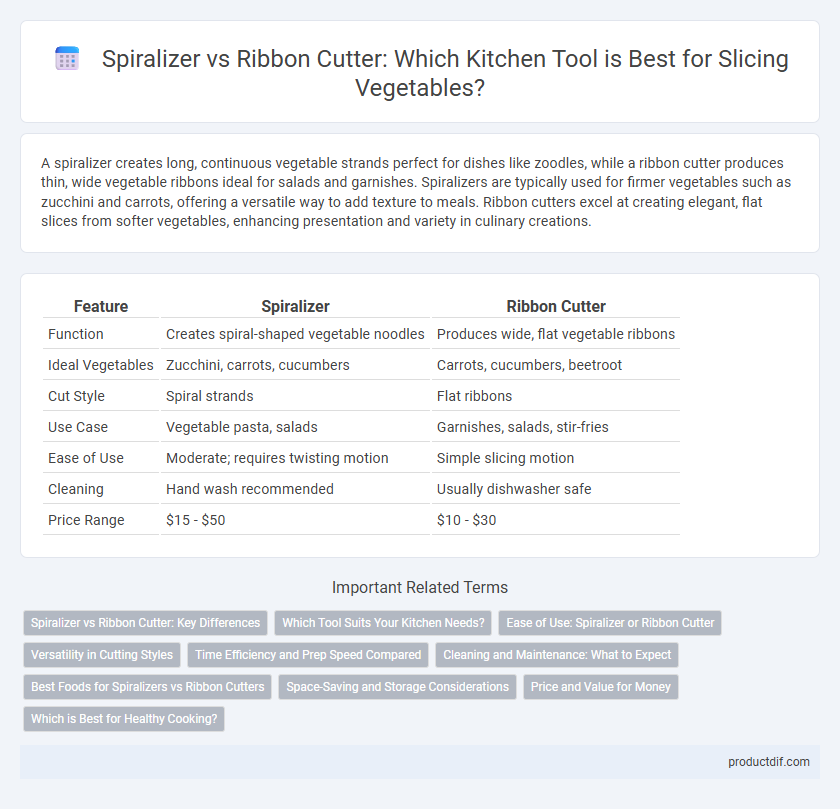A spiralizer creates long, continuous vegetable strands perfect for dishes like zoodles, while a ribbon cutter produces thin, wide vegetable ribbons ideal for salads and garnishes. Spiralizers are typically used for firmer vegetables such as zucchini and carrots, offering a versatile way to add texture to meals. Ribbon cutters excel at creating elegant, flat slices from softer vegetables, enhancing presentation and variety in culinary creations.
Table of Comparison
| Feature | Spiralizer | Ribbon Cutter |
|---|---|---|
| Function | Creates spiral-shaped vegetable noodles | Produces wide, flat vegetable ribbons |
| Ideal Vegetables | Zucchini, carrots, cucumbers | Carrots, cucumbers, beetroot |
| Cut Style | Spiral strands | Flat ribbons |
| Use Case | Vegetable pasta, salads | Garnishes, salads, stir-fries |
| Ease of Use | Moderate; requires twisting motion | Simple slicing motion |
| Cleaning | Hand wash recommended | Usually dishwasher safe |
| Price Range | $15 - $50 | $10 - $30 |
Spiralizer vs Ribbon Cutter: Key Differences
Spiralizers create continuous, noodle-like spirals from vegetables, ideal for zucchini or carrot pasta substitutes, while ribbon cutters produce flat, wide vegetable strips resembling fettuccine or pappardelle. The spiralizer's blade design emphasizes producing long, curly strands, enhancing texture and presentation in dishes, whereas ribbon cutters focus on producing thin, flat ribbons for salads or stir-fries. Choosing between a spiralizer and a ribbon cutter depends on the desired shape and texture of the vegetable preparation in culinary applications.
Which Tool Suits Your Kitchen Needs?
Choosing between a spiralizer and a ribbon cutter depends on your cooking style and the types of dishes you frequently prepare. A spiralizer excels at creating uniform, curly vegetable strands perfect for salads, stir-fries, or low-carb pasta substitutes, while a ribbon cutter produces flat, wide strips ideal for garnishes or layering in casseroles and baked dishes. Evaluating the versatility, ease of use, and the texture you want to achieve in your meals helps determine which kitchen tool best suits your culinary needs.
Ease of Use: Spiralizer or Ribbon Cutter
Spiralizers offer user-friendly designs with simple crank handles and secure grips, making it easy to create uniform spirals from vegetables like zucchini and carrots. Ribbon cutters, often featuring straight blades, require slightly more manual control to produce thin, flat strips suited for garnishes or salads. Both tools streamline prep work, but spiralizers tend to be preferred for effortless, hands-free operation and consistent results.
Versatility in Cutting Styles
Spiralizers excel in creating consistent, spiral-shaped vegetable noodles ideal for zucchini, carrots, and sweet potatoes, while ribbon cutters offer diverse slicing options that produce thin, wide ribbons suitable for salads and garnishes. The spiralizer's specialized design is perfect for making healthy, low-carb pasta alternatives, whereas the ribbon cutter provides flexibility in preparing a variety of dishes with different textures. Both tools enhance culinary creativity, but choosing between them depends on whether uniform spirals or adjustable ribbon widths are prioritized in meal preparation.
Time Efficiency and Prep Speed Compared
Spiralizers create uniform vegetable spirals quickly, making them ideal for fast meal prep and intricate garnishes. Ribbon cutters efficiently produce thin, wide vegetable strips, optimized for salads and stir-fries, with slightly less precision but faster overall slicing. Choosing between them depends on the desired cut style and the balance between precision and speed in kitchen workflows.
Cleaning and Maintenance: What to Expect
Spiralizers typically feature fewer parts and simpler designs, making them easier to clean quickly, often requiring only a brush to remove vegetable residue from the blades. Ribbon cutters have more intricate blade arrangements that can trap food particles, necessitating thorough hand washing and occasional disassembly to maintain hygiene and optimal performance. Regular cleaning of both tools prevents rust and extends their lifespan, with dishwasher-safe models offering added convenience for busy kitchens.
Best Foods for Spiralizers vs Ribbon Cutters
Spiralizers excel at creating long, curly strands from firm vegetables like zucchini, carrots, and cucumbers, perfect for veggie noodles and salads. Ribbon cutters work best with softer produce such as potatoes, beets, and sweet potatoes, producing wide, flat ribbons ideal for lasagna or garnishes. Both tools enhance meal presentation and texture, but choosing the right device depends on the desired shape and type of vegetable.
Space-Saving and Storage Considerations
A spiralizer typically takes up more vertical space with its larger base and multiple attachments, while a ribbon cutter is generally compact and easier to store in kitchen drawers or small cabinets. Spiralizers often require countertop room during use, whereas ribbon cutters can be handheld and quickly put away, making them ideal for kitchens with limited space. Choosing between the two depends on available storage options and how frequently you plan to prepare vegetable noodles or ribbons.
Price and Value for Money
Spiralizers typically cost between $20 and $50, offering versatile vegetable cutting with multiple blade options, making them a cost-effective choice for frequent use. Ribbon cutters are generally priced lower, around $10 to $30, but may lack the variety and precision of a spiralizer, which can impact long-term value. Choosing a kitchen tool depends on balancing initial investment against functionality, with spiralizers providing greater value for those seeking diverse vegetable preparation options.
Which is Best for Healthy Cooking?
A spiralizer creates long, continuous vegetable noodles, ideal for low-carb and gluten-free meals, while a ribbon cutter produces wider, flat vegetable strips perfect for salads and stir-fries. Spiralizers excel in maximizing vegetable intake by transforming zucchini, carrots, and cucumbers into pasta alternatives, boosting fiber and nutrient consumption. Ribbon cutters offer versatility for varied textures and presentation, but spiralizers are superior for those prioritizing calorie control and healthier meal substitutions.
Spiralizer vs ribbon cutter Infographic

 productdif.com
productdif.com